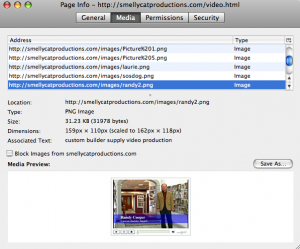 It’s important to use your keywords in the titles and descriptions of your website’s images. This is called “alt text”, and search engines “see” this as well.
It’s important to use your keywords in the titles and descriptions of your website’s images. This is called “alt text”, and search engines “see” this as well.
Keywords are also important to have in your content throughout your website–not just on the home page.
How many of you have noticed that when you do a search for something and you click on the website link, you land on a page other than that website’s home page? The reason for this is that that web page you landed on first, has that search term you used somewhere in it, either in the title, the text, or alt text of an image.
Each page of your website should be “keyword rich” with keywords relevant to the page in its Metadata, alt text and content. For instance, if you visit our Smellycat Productions web design or video production page, you’ll see that we use the keywords or variations of the keywords, “web design” and “video” a number of times on the page, and in the alt text, which makes the pages “keyword rich”.
Now, it’s important to distinguish between keyword rich and keyword “stuffing”. If you create good content full of keywords that is relevant to what a particular page is about, that’s considered a keyword rich page. If you just write the same keywords over and over again, like “video production, video production, video production”, either in the website content or the Metadata, that’s considered keyword “stuffing” and could get your website kicked off the search engines.
In our next post, we’ll discuss the importance of domain age, as well as page rank. In the meantime, are you finding these posts helpful? Do you have a specific question about optimization? If so, feel free to add a comment, or email us.

One Comment